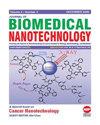Overexpression of Homeobox Containing1 Relieves Myocardial Fibrosis and Inflammation in Diabetic Cardiomyopathy Rats
IF 2.9
4区 医学
Q1 Medicine
引用次数: 0
Abstract
This study aimed to investigate the impact of Homeobox containing1 (HMBOX1) on heart structure and function in Diabetic Cardiomyopathy (DCM) rats. DCM is the leading cause of death in diabetic patients, significantly affecting their quality of life. The DCM rat model was created using a high-fat diet and streptozotocin injection. The success of the model was determined by assessing heart weight, diet, urine output, and cardiac function. HMBOX1 expression in cardiomyocytes of normal and DCM rats was compared. HMBOX1 expression was enhanced in DCM rat cardiomyocytes through jugular vein injection of HMBOX1 lentivirus. The effects of HMBOX1 on myocardial structure, function, collagen levels, inflammatory factors, and the TGF-β/Smad3 signaling pathway in DCM rats were evaluated. DCM rats exhibited increased heart weight, diet, and impaired heart function, confirming successful model creation. HMBOX1 expression was significantly lower in DCM rat cardiomyocytes compared to the control group. Augmenting HMBOX1 expression in DCM rat cardiomyocytes improved cardiac function, myocardial morphology, and reduced collagen I and collagen III expression. HMBOX1 also mitigated inflammation in myocardial tissues. Furthermore, HMBOX1 inhibited the TGF-β/Smad3 signaling pathway in DCM rat cardiomyocytes. Overall, HMBOX1 alleviated DCM by reducing myocardial fibrosis and inflammation via TGF-β/Smad3 signaling pathway inhibition过表达含 Homeoboxing1 可缓解糖尿病心肌病大鼠的心肌纤维化和炎症反应
本研究旨在探讨含 Homeobox1(HMBOX1)对糖尿病心肌病(DCM)大鼠心脏结构和功能的影响。糖尿病心肌病是糖尿病患者的主要死因,严重影响他们的生活质量。糖尿病心肌病大鼠模型是通过高脂饮食和注射链脲佐菌素建立的。该模型的成功与否取决于心脏重量、饮食、尿量和心脏功能的评估。比较了正常大鼠和 DCM 大鼠心肌细胞中 HMBOX1 的表达。通过颈静脉注射 HMBOX1 慢病毒,增强了 HMBOX1 在 DCM 大鼠心肌细胞中的表达。评估了 HMBOX1 对 DCM 大鼠心肌结构、功能、胶原蛋白水平、炎症因子和 TGF-β/Smad3 信号通路的影响。DCM 大鼠表现出心脏重量增加、节食和心脏功能受损,证实了模型的成功创建。与对照组相比,DCM 大鼠心肌细胞中 HMBOX1 的表达明显降低。增强 DCM 大鼠心肌细胞中 HMBOX1 的表达可改善心脏功能和心肌形态,减少胶原 I 和胶原 III 的表达。 HMBOX1 还能减轻心肌组织的炎症反应。此外,HMBOX1 还抑制了 DCM 大鼠心肌细胞中的 TGF-β/Smad3 信号通路。总之,HMBOX1 可通过抑制 TGF-β/Smad3 信号通路减轻心肌纤维化和炎症,从而缓解 DCM。
本文章由计算机程序翻译,如有差异,请以英文原文为准。
求助全文
约1分钟内获得全文
求助全文
来源期刊
CiteScore
4.30
自引率
17.20%
发文量
145
审稿时长
2.3 months
期刊介绍:
Information not localized

 求助内容:
求助内容: 应助结果提醒方式:
应助结果提醒方式:


